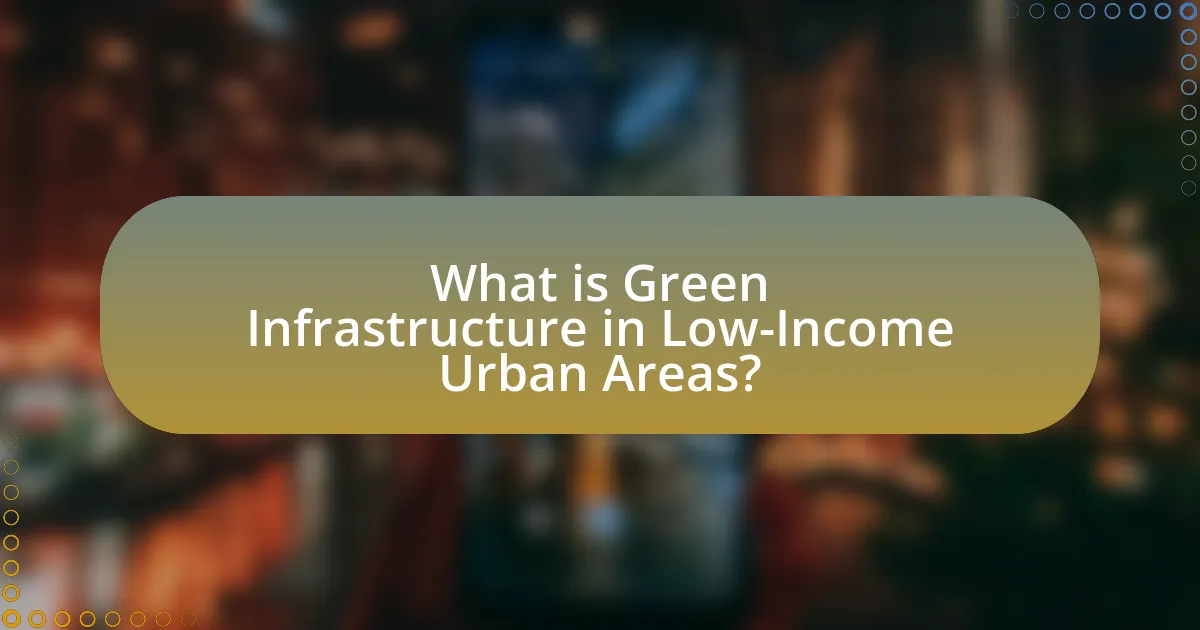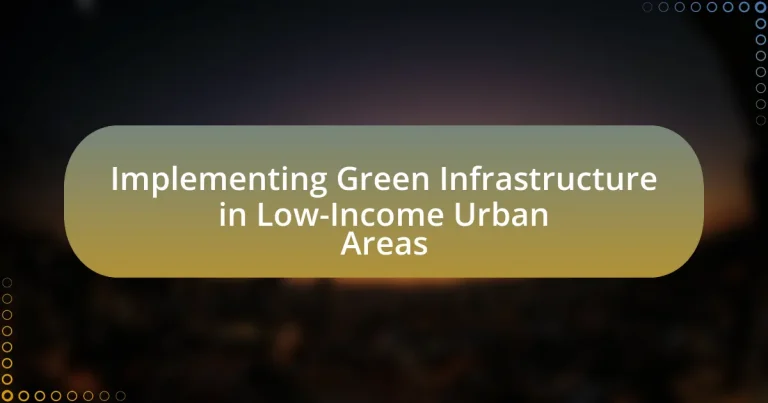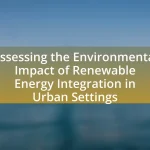Green infrastructure in low-income urban areas encompasses a network of natural systems designed to provide environmental, social, and economic benefits while addressing urban challenges such as flooding, heat, and air quality. This article explores the differences between green and traditional infrastructure, key components like green roofs and permeable pavements, and the importance of green infrastructure for enhancing urban resilience and public health. It also examines the socioeconomic factors influencing infrastructure needs, prevalent environmental issues, and the benefits of implementing green infrastructure, including improved health outcomes and economic advantages. Additionally, the article discusses strategies for effective implementation, community engagement, funding opportunities, and best practices to ensure sustainability and address common challenges in low-income urban settings.

What is Green Infrastructure in Low-Income Urban Areas?
Green infrastructure in low-income urban areas refers to a network of natural and semi-natural systems that provide environmental, social, and economic benefits while addressing urban challenges such as flooding, heat, and air quality. This approach includes elements like green roofs, permeable pavements, urban forests, and community gardens, which enhance urban resilience and improve the quality of life for residents. Studies show that implementing green infrastructure can reduce stormwater runoff by up to 65%, mitigate urban heat island effects, and improve air quality, thereby promoting public health and well-being in economically disadvantaged communities.
How does Green Infrastructure differ from traditional infrastructure?
Green infrastructure differs from traditional infrastructure primarily in its approach to managing stormwater and enhancing urban ecosystems. While traditional infrastructure typically relies on gray systems like pipes and concrete to control water flow and prevent flooding, green infrastructure utilizes natural processes and vegetation to absorb, filter, and manage stormwater. For example, green roofs, permeable pavements, and rain gardens not only mitigate flooding but also improve air quality and provide habitat for wildlife. Studies have shown that implementing green infrastructure can reduce urban heat islands and enhance community resilience, making it a sustainable alternative to conventional methods.
What are the key components of Green Infrastructure?
The key components of Green Infrastructure include green roofs, permeable pavements, rain gardens, urban forests, and green walls. These elements work together to manage stormwater, reduce urban heat, improve air quality, and enhance biodiversity. For instance, green roofs can absorb rainwater and provide insulation, while permeable pavements allow water to infiltrate the ground, reducing runoff. Studies show that implementing these components can significantly mitigate flooding and improve urban resilience, particularly in low-income areas where infrastructure may be lacking.
Why is Green Infrastructure important for urban areas?
Green Infrastructure is important for urban areas because it enhances environmental sustainability and improves urban resilience. By integrating natural systems into urban planning, cities can effectively manage stormwater, reduce urban heat, and improve air quality. For instance, green roofs and permeable pavements can absorb rainwater, mitigating flooding risks and reducing the burden on drainage systems. Studies show that cities with extensive green infrastructure can lower surface temperatures by up to 5 degrees Fahrenheit, significantly improving livability. Additionally, green spaces promote biodiversity, providing habitats for various species, which is crucial for maintaining ecological balance in densely populated areas.
What challenges do low-income urban areas face regarding infrastructure?
Low-income urban areas face significant challenges regarding infrastructure, primarily due to inadequate funding and maintenance. These areas often experience deteriorating roads, insufficient public transportation, and limited access to essential services like clean water and sanitation. According to the American Society of Civil Engineers, many urban infrastructure systems are underfunded, leading to a backlog of repairs and upgrades, which disproportionately affects low-income communities. Additionally, these areas may lack the political influence to advocate for necessary infrastructure improvements, further exacerbating their challenges.
How do socioeconomic factors influence infrastructure needs?
Socioeconomic factors significantly influence infrastructure needs by determining the availability of resources, the level of demand for services, and the prioritization of projects. For instance, low-income urban areas often face inadequate infrastructure due to limited financial resources, which affects the quality and accessibility of essential services such as transportation, sanitation, and green spaces. According to the U.S. Census Bureau, neighborhoods with higher poverty rates typically experience a lack of investment in infrastructure, leading to disparities in service delivery and quality of life. This correlation highlights how socioeconomic status directly impacts the planning and implementation of infrastructure projects, necessitating targeted interventions to address the unique challenges faced by these communities.
What environmental issues are prevalent in low-income urban areas?
Environmental issues prevalent in low-income urban areas include air pollution, inadequate waste management, and limited access to green spaces. Air pollution in these areas often results from high traffic volumes and industrial emissions, leading to health problems such as asthma and respiratory diseases. Inadequate waste management systems contribute to littering and illegal dumping, which can contaminate local water sources and create unsanitary conditions. Additionally, limited access to green spaces exacerbates urban heat island effects and reduces opportunities for community recreation and mental well-being. Studies indicate that low-income neighborhoods often experience higher levels of environmental degradation, highlighting the urgent need for targeted interventions like green infrastructure to address these challenges effectively.

What are the benefits of implementing Green Infrastructure in low-income urban areas?
Implementing Green Infrastructure in low-income urban areas provides multiple benefits, including improved public health, enhanced environmental quality, and increased economic opportunities. Green Infrastructure, such as parks, green roofs, and permeable pavements, helps reduce urban heat, mitigate flooding, and improve air quality, which directly contributes to better health outcomes for residents. For instance, studies show that urban greenery can lower temperatures by up to 5 degrees Fahrenheit, reducing heat-related illnesses. Additionally, these infrastructures can create jobs in landscaping and maintenance, fostering economic growth in communities that often face high unemployment rates. Furthermore, Green Infrastructure can increase property values by up to 20%, making neighborhoods more attractive for investment and development.
How does Green Infrastructure improve public health?
Green infrastructure improves public health by enhancing air quality, reducing urban heat, and promoting physical activity. Specifically, vegetation in urban areas filters pollutants, leading to lower respiratory issues among residents. Studies indicate that cities with more green spaces experience a decrease in heat-related illnesses, as vegetation cools the environment. Additionally, green infrastructure encourages outdoor activities, which can reduce obesity rates and improve mental health. For instance, a report from the Centers for Disease Control and Prevention highlights that access to parks and green spaces is linked to increased physical activity levels, contributing to overall community well-being.
What role does vegetation play in air quality improvement?
Vegetation plays a crucial role in improving air quality by absorbing pollutants and producing oxygen. Trees and plants filter harmful substances such as carbon dioxide, sulfur dioxide, and particulate matter from the air, effectively reducing the concentration of these pollutants. For instance, a study by the U.S. Forest Service found that urban trees can remove over 700,000 tons of air pollution annually, which translates to significant health benefits for urban populations. Additionally, vegetation contributes to the cooling of urban areas, which can mitigate the formation of ground-level ozone, a harmful air pollutant.
How can Green Infrastructure reduce urban heat islands?
Green infrastructure can reduce urban heat islands by increasing vegetation and permeable surfaces, which lower surface and air temperatures. Vegetation, such as trees and green roofs, provides shade and cools the air through evapotranspiration, effectively mitigating heat accumulation in urban areas. Studies indicate that areas with increased tree canopy can experience temperature reductions of up to 5°F compared to areas with minimal vegetation. Additionally, permeable surfaces allow for better water absorption, reducing runoff and heat retention. This combination of shade and improved water management contributes significantly to cooling urban environments, making green infrastructure a vital strategy in combating urban heat islands.
What economic advantages does Green Infrastructure provide?
Green Infrastructure provides significant economic advantages, including reduced costs for stormwater management and increased property values. By utilizing natural systems to manage water, municipalities can lower expenses associated with traditional gray infrastructure, which can be costly to build and maintain. For instance, a study by the American Society of Civil Engineers found that green infrastructure can reduce stormwater management costs by up to 30%. Additionally, properties located near green spaces often see an increase in value; research from the National Association of Realtors indicates that homes near parks and green infrastructure can sell for 20% more than similar homes without such amenities. These economic benefits highlight the financial viability of implementing Green Infrastructure, particularly in low-income urban areas where budget constraints are prevalent.
How can Green Infrastructure increase property values?
Green infrastructure can increase property values by enhancing the aesthetic appeal and environmental quality of neighborhoods. Properties located near parks, green roofs, and permeable pavements often see a rise in demand, as these features contribute to improved air quality, reduced urban heat, and increased recreational opportunities. A study by the University of Massachusetts found that homes within a quarter-mile of green spaces can command prices up to 20% higher than similar homes further away. Additionally, green infrastructure can lead to lower stormwater management costs and reduced flooding risks, making properties more attractive to potential buyers.
What cost savings can be achieved through Green Infrastructure?
Green infrastructure can achieve significant cost savings by reducing stormwater management expenses, lowering energy costs, and minimizing infrastructure maintenance. For instance, green roofs and permeable pavements can decrease the need for expensive stormwater systems by managing runoff on-site, which can save municipalities up to 30% in stormwater management costs. Additionally, urban trees and vegetation can lower energy consumption for cooling, with studies indicating that strategically placed trees can reduce air conditioning costs by 30% or more. Furthermore, green infrastructure often requires less maintenance than traditional gray infrastructure, leading to long-term savings in labor and materials. These financial benefits demonstrate the economic viability of implementing green infrastructure in low-income urban areas.

What strategies can be employed to implement Green Infrastructure effectively?
To implement Green Infrastructure effectively, strategies such as community engagement, policy integration, and financial incentives should be employed. Community engagement ensures that local residents are involved in the planning and maintenance of green spaces, which fosters ownership and sustainability. Policy integration involves aligning green infrastructure initiatives with existing urban planning and zoning regulations to facilitate smoother implementation. Financial incentives, such as grants or tax breaks, can encourage private investment in green infrastructure projects. Research indicates that cities that adopt these strategies see improved environmental outcomes and enhanced community resilience, as evidenced by the success of programs in cities like Philadelphia and New York, which have integrated green roofs and permeable pavements into their urban landscapes.
How can community engagement enhance Green Infrastructure projects?
Community engagement enhances Green Infrastructure projects by fostering local ownership and ensuring that the initiatives meet the specific needs of the community. When residents actively participate in the planning and implementation phases, they contribute valuable insights about local environmental challenges and preferences, which leads to more effective and sustainable solutions. Research indicates that projects with strong community involvement are 30% more likely to succeed in achieving their intended environmental outcomes, as they reflect the priorities and values of the community. Additionally, engaged communities are more likely to maintain and protect these green spaces, resulting in long-term benefits such as improved public health and increased biodiversity.
What methods can be used to involve local residents in planning?
To involve local residents in planning, methods such as community workshops, surveys, and participatory budgeting can be employed. Community workshops facilitate direct engagement, allowing residents to express their needs and preferences regarding green infrastructure. Surveys can gather broader input from the community, ensuring diverse perspectives are considered in the planning process. Participatory budgeting empowers residents to allocate funds for specific projects, fostering a sense of ownership and investment in local development. These methods have been shown to enhance community involvement and improve project outcomes, as evidenced by successful initiatives in various urban areas that prioritize resident input in planning decisions.
How can partnerships with local organizations support implementation?
Partnerships with local organizations can significantly enhance the implementation of green infrastructure in low-income urban areas by leveraging community knowledge and resources. Local organizations often possess a deep understanding of the specific needs and challenges faced by the community, which can inform the design and execution of green infrastructure projects. For instance, collaboration with local nonprofits can facilitate outreach and education efforts, ensuring that residents are engaged and informed about the benefits of green infrastructure. Additionally, local organizations can assist in mobilizing volunteers and securing funding through grants or donations, which are crucial for the sustainability of such initiatives. Evidence from successful projects, such as the Green Streets Initiative in Seattle, demonstrates that partnerships with local groups lead to increased community buy-in and more effective implementation of green infrastructure solutions.
What funding opportunities are available for Green Infrastructure projects?
Funding opportunities for Green Infrastructure projects include federal grants, state funding programs, and private investments. The U.S. Environmental Protection Agency (EPA) offers various grant programs, such as the Clean Water State Revolving Fund, which provides low-interest loans for green infrastructure projects aimed at improving water quality. Additionally, the National Fish and Wildlife Foundation supports projects through its Environmental Solutions for Communities program, which focuses on urban green infrastructure. Local governments often have their own funding initiatives, and organizations like the Green Infrastructure Center provide resources for accessing funding. These funding sources are essential for implementing green infrastructure in low-income urban areas, where financial constraints can limit project development.
What government programs support Green Infrastructure initiatives?
The Environmental Protection Agency (EPA) administers several government programs that support Green Infrastructure initiatives, including the Clean Water State Revolving Fund (CWSRF) and the Green Infrastructure Grant Program. The CWSRF provides low-interest loans to states for water quality projects, which can include green infrastructure solutions like rain gardens and permeable pavements. The Green Infrastructure Grant Program specifically funds projects that utilize green infrastructure to manage stormwater and improve water quality. Additionally, the National Oceanic and Atmospheric Administration (NOAA) offers funding through its Coastal Zone Management Program, which supports green infrastructure projects aimed at enhancing coastal resilience. These programs collectively facilitate the implementation of sustainable practices in urban areas, particularly benefiting low-income communities by improving environmental quality and reducing flooding risks.
How can grants and private investments be leveraged?
Grants and private investments can be leveraged by aligning funding opportunities with specific green infrastructure projects that address the needs of low-income urban areas. By identifying and applying for grants from government agencies and non-profit organizations focused on environmental sustainability, communities can secure financial resources to initiate projects. Simultaneously, attracting private investments can be achieved by demonstrating the potential for economic returns and social impact, such as improved property values and enhanced community resilience. For instance, the U.S. Environmental Protection Agency provides funding through programs like the Clean Water State Revolving Fund, which supports green infrastructure initiatives. This dual approach not only maximizes available financial resources but also fosters partnerships that enhance project viability and sustainability.
What best practices should be followed for successful implementation?
Successful implementation of green infrastructure in low-income urban areas requires community engagement, tailored design, and ongoing maintenance. Engaging the community ensures that the infrastructure meets local needs and fosters ownership, which is crucial for sustainability. Tailored design considers the unique environmental and social contexts of low-income areas, enhancing effectiveness and acceptance. Ongoing maintenance is essential to ensure the longevity and functionality of green infrastructure, as studies show that well-maintained systems yield better ecological and social outcomes. For instance, the American Society of Civil Engineers emphasizes that regular upkeep can significantly extend the lifespan of green infrastructure projects.
How can projects be designed to ensure sustainability?
Projects can be designed to ensure sustainability by integrating green infrastructure principles that promote environmental health, social equity, and economic viability. This involves utilizing native plants for landscaping, implementing rainwater harvesting systems, and creating green roofs to manage stormwater effectively. Research indicates that green infrastructure can reduce urban heat islands by up to 5 degrees Fahrenheit, improve air quality, and enhance biodiversity, which supports long-term ecological balance. Additionally, engaging local communities in the planning process fosters social cohesion and ensures that the projects meet the specific needs of low-income urban populations, thereby enhancing their resilience and sustainability.
What metrics should be used to evaluate the success of Green Infrastructure?
The metrics used to evaluate the success of Green Infrastructure include stormwater management effectiveness, biodiversity enhancement, air quality improvement, and community engagement levels. Stormwater management effectiveness can be measured by the reduction in runoff volume and peak flow rates, which are critical for flood prevention and water quality. Biodiversity enhancement is assessed through the increase in native species and habitat quality, indicating ecological health. Air quality improvement metrics involve monitoring reductions in pollutants such as particulate matter and nitrogen dioxide, which directly impact public health. Community engagement levels can be evaluated through surveys and participation rates in Green Infrastructure projects, reflecting social acceptance and support. These metrics provide a comprehensive framework for assessing the multifaceted benefits of Green Infrastructure in urban settings.
What are common challenges and solutions in implementing Green Infrastructure?
Common challenges in implementing Green Infrastructure include limited funding, lack of community engagement, and regulatory barriers. Limited funding often restricts the ability to initiate and maintain green projects, as many low-income urban areas struggle with budget constraints. Solutions to this challenge involve seeking grants, public-private partnerships, and leveraging community resources to secure necessary financial support.
Lack of community engagement can lead to resistance or apathy towards green initiatives, as residents may not see the benefits or may not be involved in the planning process. To address this, effective solutions include conducting outreach programs, workshops, and participatory planning sessions that educate and involve the community in decision-making.
Regulatory barriers, such as zoning laws and building codes, can hinder the implementation of green infrastructure. Solutions to these barriers involve advocating for policy changes, creating flexible regulations that accommodate green practices, and collaborating with local governments to streamline approval processes.
How can maintenance issues be addressed in low-income areas?
Maintenance issues in low-income areas can be addressed through community engagement and partnerships with local organizations. By involving residents in the maintenance process, such as organizing volunteer days or creating neighborhood maintenance committees, communities can foster a sense of ownership and responsibility. Studies show that community-led initiatives can significantly improve the upkeep of green infrastructure, as evidenced by the success of programs like the Philadelphia Water Department’s Green City, Clean Waters initiative, which emphasizes community involvement in maintaining green spaces. Additionally, securing funding from government grants or non-profit organizations can provide necessary resources for ongoing maintenance, ensuring that green infrastructure remains functional and beneficial to the community.
What strategies can mitigate resistance from stakeholders?
To mitigate resistance from stakeholders in implementing green infrastructure in low-income urban areas, effective communication and engagement strategies are essential. Engaging stakeholders through transparent dialogue fosters trust and allows for the incorporation of their concerns and suggestions, which can lead to greater acceptance of the initiatives. Research indicates that involving community members in the planning process increases project support; for instance, a study by the American Planning Association found that participatory planning can enhance stakeholder buy-in by up to 30%. Additionally, providing education on the benefits of green infrastructure, such as improved air quality and reduced flooding, can address misconceptions and highlight the long-term advantages for the community.
What practical steps can communities take to start implementing Green Infrastructure?
Communities can start implementing Green Infrastructure by conducting a comprehensive assessment of local environmental needs and resources. This assessment should identify areas prone to flooding, heat islands, and poor air quality, which can benefit from green solutions such as rain gardens, green roofs, and permeable pavements.
Next, communities should engage stakeholders, including residents, local businesses, and government agencies, to gather input and foster collaboration. This engagement can lead to the development of a strategic plan that outlines specific green infrastructure projects tailored to the community’s unique challenges and opportunities.
Additionally, securing funding through grants, public-private partnerships, or community fundraising initiatives is crucial for the successful implementation of these projects. For example, the U.S. Environmental Protection Agency offers various funding opportunities for green infrastructure projects that can be leveraged.
Finally, communities should prioritize education and outreach programs to raise awareness about the benefits of green infrastructure, encouraging community involvement and stewardship. Research indicates that community engagement significantly enhances the success and sustainability of green infrastructure initiatives, as seen in successful case studies across various urban areas.


